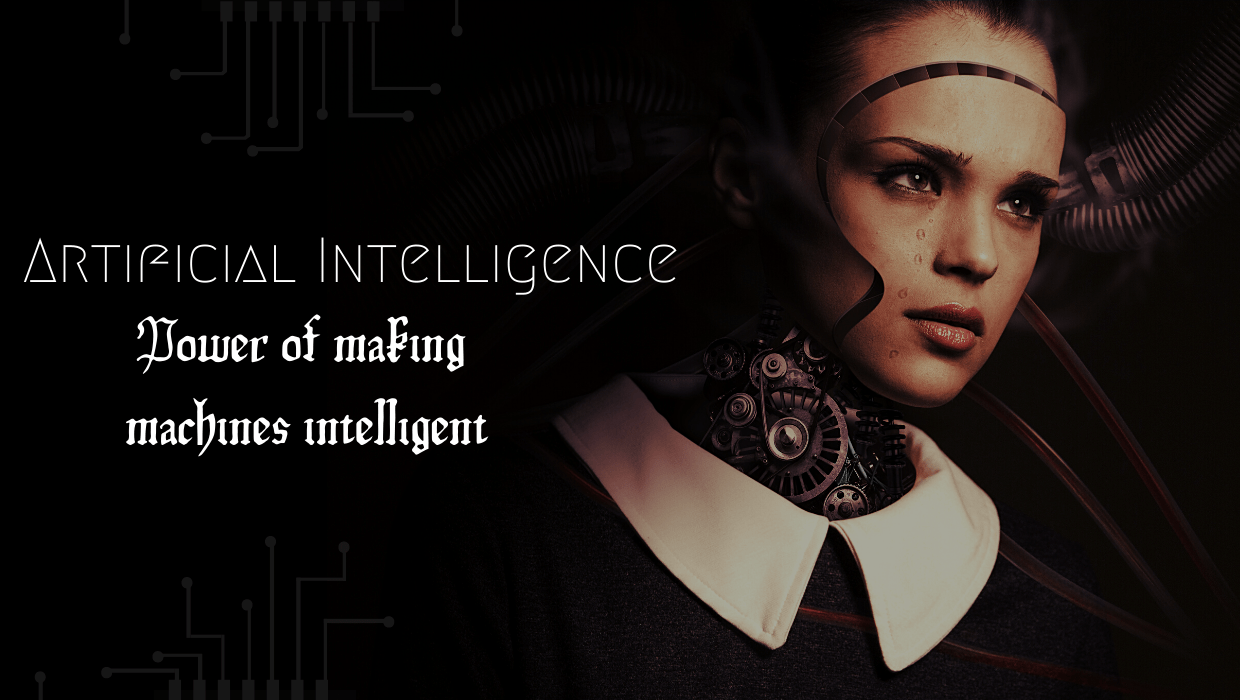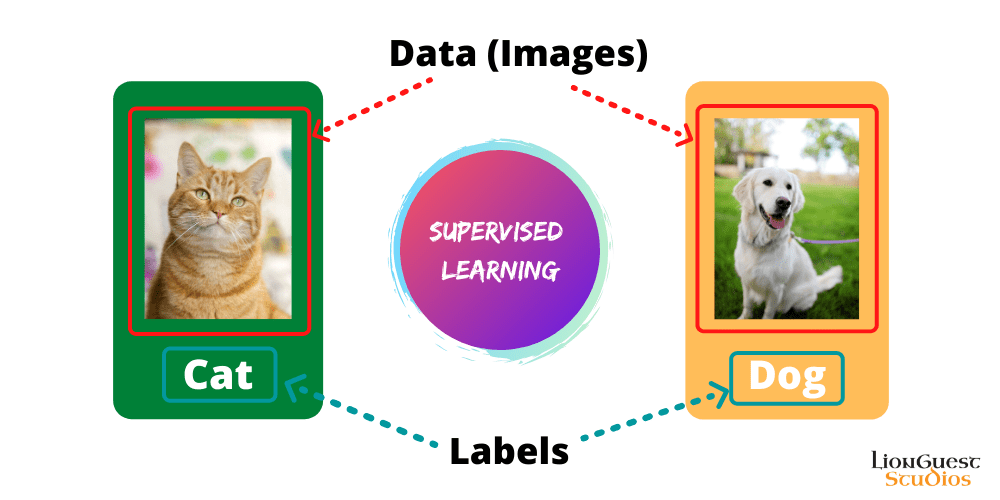Artificial Intelligence – Power of making machines intelligent
 Sahil Bhosale
Sahil Bhosale
What is Artificial Intelligence?
“Providing intelligence to a machine” is what we call artificial intelligence. This is the most simple, appropriate, and logical one-line definition of Artificial Intelligence (AI).
Artificial means a system that has been created or developed by humans and intelligence means an ability to think. The main goal here is to make machines think like humans and make them do all those things that humans are capable of doing. Now the question is how to make a machine intelligent and make them do the things which humans can do? To make artificial systems think like humans we need some knowledge or data.
So you might be thinking why do we require data or knowledge to make a machine intelligent? To understand this thing you first have to understand how the human brain works and how people think in general. We humans think or predict based on the knowledge or the data which we have gained from the surrounding, books, peers, etc and the most important thing which is learning from our own mistakes and based on this we make further decisions and act accordingly in the environment (the world).
The same thing goes with artificial systems. They also take the data, process it, make mistakes, and learns from those mistakes, and then they take much more accurate decisions through experience along the way.
We have now understood why we need data so let’s address another question which is where to use this data or how to feed it into a machine to make it intelligent? For this we create models and we called them Machine Learning (ML) models. The model works the same way as the human brain. We need a lot of data so that our ML models can make accurate decisions. And this collection of large amounts of data is called a dataset.
This dataset is further broken down into 2 parts one is called trained data (will be used to train the ML model) and another is called test data (will be used to test the model after training). We don’t do this manually we have tools in python to do this. And this division of dataset into 2 parts is not an exact 50-50% breakup its approximately 50%.
Artificial intelligence and its subfields
Artificial Intelligence has various subfields but out of them, the most popular ones are Natural Language Processing (NLP), Machine Learning (ML), & Computer Vision.
Natural Language Processing (NLP)
Natural Language Processing (NLP) deals with the processing of human language like English and making it understandable to a machine so that it will know how to respond when humans speak to them. Applications of NLP would be Amazon Alexa, Apple’s Siri, or Google Assistant.
You just have to speak or provide tasks to these devices by communicating with them by asking questions such as what is the weather? or turning on the lights, etc through your language and then they will process your language and provide responses accordingly.
Computer Vision
Computer Vision deals with identifying the objects in an image or in a video stream. The most popular example of computer vision would be self-driving cars.
Machine Learning
Another most popular subfield of artificial intelligence is Machine Learning(ML). Machine Learning provides an ability to a machine to think, learn, and to predict. By using Machine Learning we don’t have to explicitly program a machine to do a particular task by writing a lot of if and else statements.
Deep Learning is a subfield of Machine Learning in artificial intelligence (AI) which uses neural networks to make even accurate decisions like that of the human brain.
Types of learning in ML
There are different ways in which we can teach a machine how to learn. The main ingredient for making machines capable of learning is the data or the dataset which we use. We take this dataset and apply a learning technique (from the ones which have mentioned below) and accordingly feed the data to a machine learning model so to make machines understand things. Each of these techniques works differently and this is what we will see below.
Supervised Learning
In Supervised Learning, we have the dataset and each data point (single unit of information) in that dataset is associated with a label. So, whenever we pass this dataset as an input to an ML model we also specific beforehand what will be the output for all the data points in that particular dataset.

Let’s say we have images of a cat and a dog as the input data as shown above. Here, we also tell the model what each of these images represents, either it is a cat or it is a dog. The names which are used to represent these images are known as labels.
Supervised Learning Algorithms:
Linear Regression
Logistic Regression
K-Nearest Neighbors
Decision Tree
Random Forest
Support Vector Machines
Unsupervised Learning
In Unsupervised Learning, unlike in supervised learning where we know the input as well as the output beforehand here we only know the input and we have to predict the output. Now to predict the output we use a concept called as clustering meaning grouping of the data.
In the above plot, we have plotted all of our data points from the dataset on to a graph, and these data points represent 3 shapes, triangles, rectangles, and circles. After identifying the shapes we have drawn 2 lines to make groups or to cluster those data points based on their properties. Here, the property could be the shape of the object.
After grouping, we can easily predict the output that the first group represents triangles, the second one represents rectangles and the last one as circles.
Types of Unsupervised Learning:
- Clustering
- Association
Reinforcement Learning
Reinforcement Learning is all about learning from the environment. In Reinforcement Learning, there is an agent that acts in the environment who takes decisions. Learning from the environment means, as the agent comes across new data which the agent as never seen before and then it tries to predict what that new data is all about and based on his decision the agent is either rewarded or being punished (penalty is imposed).
Getting started with Data Science
Picking up a Programming languages
Python: An easy to learn programming language which is one of the most popular languages when it comes to the field of Data Science.
R language: The R programming language is also great and is specifically designed for statistical computing and data analysis.
Tools and Libraries
Numpy: Numpy is a python library used for working with large multi-dimensional arrays and matrices.
Pandas: Pandas is a tool used for data manipulation and data analysis written in the python programming language.
Mathplotlib: Mathplotlib is a python library used for creating static, animated, and interactive visualizations.
Scikit-Learn: Scikit-Learn is a machine learning library for python and is used for data analysis like classification, regression, clustering, preprocessing, etc.
Tensorflow: TensorFlow is a software library for dataflow and differentiable programming which is developed by Google.
Keras: Keras is a neural network library written in Python which is capable of running on top of TensorFlow, Microsoft Cognitive Toolkit, R, Theano, or PlaidML.
Mathematics for Machine Learning (ML)
- Linear Algebra, Calculus, Statistics and Probability.
IDEs
Jupyter Notebook: Jupyter Notebook is used to write the code, equations, visualizations, and narrative text inside a web browser.
R Studio: R Studio is an Integrated Development Environment where you can write code in R programming language.
PyCharm: Pycharm is an IDE developed by JetBrains specifically for writing code in the python programming language.
Reading Research Papers of Artificial Intelligence & Machine Learning
There are various software companies that do a lot of research in the field of artificial intelligence / data science and publish research papers. One of the great companies in this field is DeepMind which is now acquired by Google.
DeepMind: https://deepmind.com/research
These papers might be confusing to understand but don’t worry these are complex research papers and its ok if you don’t completely understand them. You will get used to it as you move along in your journey.
These are some of the things which you can learn to get started with data science. Apart from this, there are a hell lot of things (tools & libraries) which are out there but the things which I have mentioned above are the basics and the building blocks for learning and getting staring into this field.
To progress in the field of data science or software development you always have to keep your self updated via reading books, blogs, videos, etc. As technology is changing rapidly the things which we use today might get deprecated or may not be in use tomorrow.
Practicing What You Have Learned so far
Just learning things will not help you also have to practice or implement what you have learned in the artificial intelligence field. For this, there is a great platform out there called Kaggle which you can use to practice the concepts of data science by taking part in the competitions.
While doing so you can also make some money if you perform well in those competitions. But don’t do it for money, your primary focus should be on learning.
Free Resources for Learning Data Science
Intro to Artificial Intelligence by Udacity
Towards Data Science Publication on Medium
A 2020 Vision of Linear Algebra by Gilbert Strang
Thanks for reading and if you like the content then support us on Patreon. Your support will surely help us in writing more of such content.
Subscribe to my newsletter
Read articles from Sahil Bhosale directly inside your inbox. Subscribe to the newsletter, and don't miss out.
Written by
